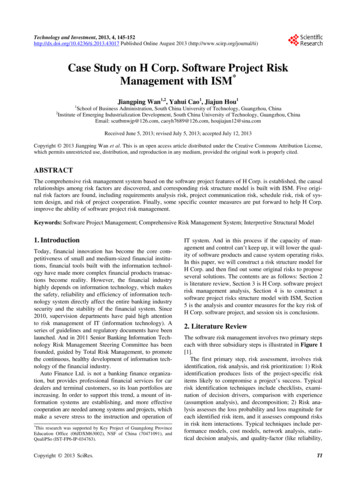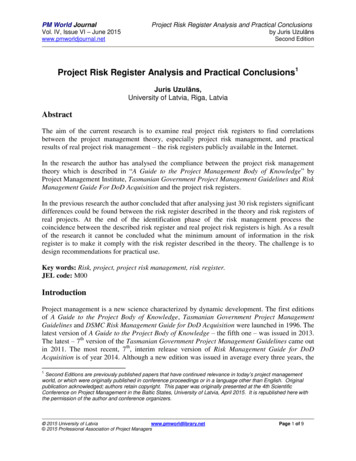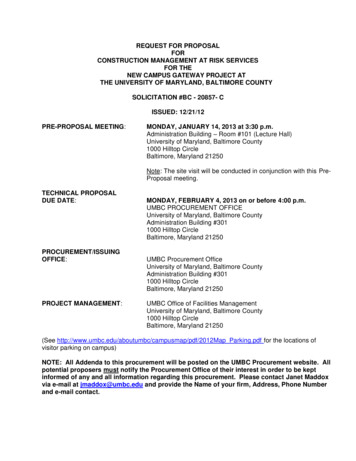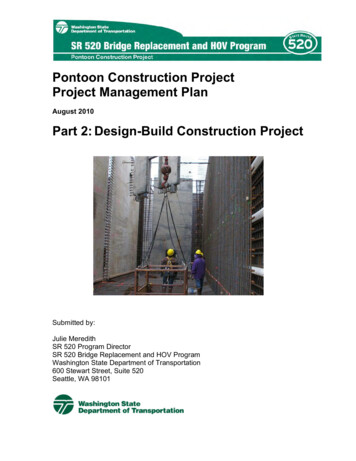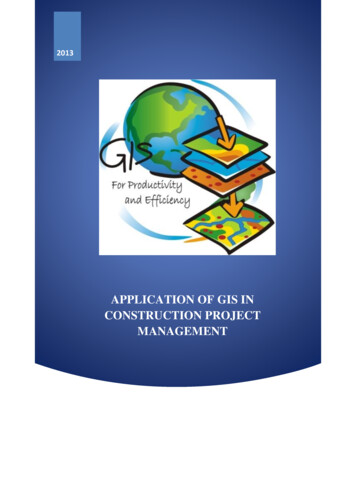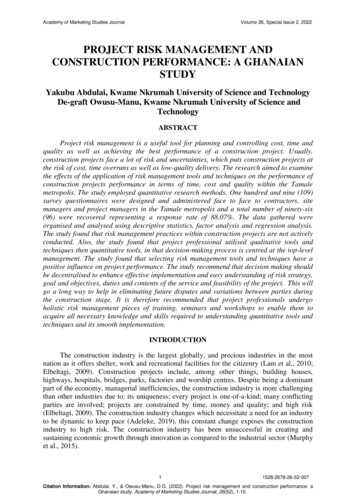
Transcription
Academy of Marketing Studies JournalVolume 26, Special Issue 2, 2022PROJECT RISK MANAGEMENT ANDCONSTRUCTION PERFORMANCE: A GHANAIANSTUDYYakubu Abdulai, Kwame Nkrumah University of Science and TechnologyDe-graft Owusu-Manu, Kwame Nkrumah University of Science andTechnologyABSTRACTProject risk management is a useful tool for planning and controlling cost, time andquality as well as achieving the best performance of a construction project. Usually,construction projects face a lot of risk and uncertainties, which puts construction projects atthe risk of cost, time overruns as well as low-quality delivery. The research aimed to examinethe effects of the application of risk management tools and techniques on the performance ofconstruction projects performance in terms of time, cost and quality within the Tamalemetropolis. The study employed quantitative research methods. One hundred and nine (109)survey questionnaires were designed and administered face to face to contractors, sitemanagers and project managers in the Tamale metropolis and a total number of ninety-six(96) were recovered representing a response rate of 88.07%. The data gathered wereorganised and analysed using descriptive statistics, factor analysis and regression analysis.The study found that risk management practices within construction projects are not activelyconducted. Also, the study found that project professional utilised qualitative tools andtechniques then quantitative tools, in that decision-making process is centred at the top-levelmanagement. The study found that selecting risk management tools and techniques have apositive influence on project performance. The study recommend that decision making shouldbe decentralised to enhance effective implementation and easy understanding of risk strategy,goal and objectives, duties and contents of the service and feasibility of the project. This willgo a long way to help in eliminating future disputes and variations between parties duringthe construction stage. It is therefore recommended that project professionals undergoholistic risk management pieces of training, seminars and workshops to enable them toacquire all necessary knowledge and skills required to understanding quantitative tools andtechniques and its smooth implementation.INTRODUCTIONThe construction industry is the largest globally, and precious industries in the mostnation as it offers shelter, work and recreational facilities for the citizenry (Lam et al., 2010;Elbeltagi, 2009). Construction projects include, among other things, building houses,highways, hospitals, bridges, parks, factories and worship centres. Despite being a dominantpart of the economy, managerial inefficiencies, the construction industry is more challengingthan other industries due to: its uniqueness; every project is one-of-a-kind; many conflictingparties are involved; projects are constrained by time, money and quality; and high risk(Elbeltagi, 2009). The construction industry changes which necessitate a need for an industryto be dynamic to keep pace (Adeleke, 2019), this constant change exposes the constructionindustry to high risk. The construction industry has been unsuccessful in creating andsustaining economic growth through innovation as compared to the industrial sector (Murphyet al., 2015).11528-2678-26-S2-007Citation Information: Abdulai, Y., & Owusu-Manu, D.G. (2022). Project risk management and construction performance: aGhanaian study. Academy of Marketing Studies Journal, 26(S2), 1-10.
Academy of Marketing Studies JournalVolume 26, Special Issue 2, 2022Risk makes the construction sector very complicated and can pose numerous internaland external threats that can stifle efficiency and even bring a well-respected and well established company to its knees. It is therefore essential to handle the multifaceted riskconnected with the construction industry in executing construction projects, not only to allowthese companies to survive or secure jobs but also to make profits.The goal of the construction project is to build something (Elbeltagi, 2009).Construction projects are varied in term of size, which involves the risk of varying degrees ofimpact (Hwang, et al. 2014). Construction projects are different from other projects, becauseof, it’s generally uniqueness, built on-site and consumes resources such as time, money,labour, equipment, and materials (Elbeltagi, 2009). According to Bahamid & Doh, (2017),Construction risk is usually viewed as occurrences that impact project objectives of cost, timeand quality. Therefore, managing project risk is an integral part of quality projectmanagement system, and necessary to achieve good project outcomes. That is, systematicidentification and assessment of risk and effectively dealing with the results is significant tothe success of the project (Abdul et al., 2015). Risk management has become an essentialaspect of project management in that; it is identified as one of the leading projectmanagement knowledge areas in the project management body of knowledge (PMBOK) bythe Project Management Institute (PMI, 2017). Risk management is an essential decisionmaking method in managing construction projects efficiently and must be maintainedthroughout the life cycle of the project, and should be based on intuition and previousexperience for a high level of judgement (Abdul et al., 2015).Many organisations from different sectors have acknowledged the growing significanceof risk management, and many have developed risk management units or departments toregulate the risk they might be or are exposed to (Chapman & Ward, 2011). This is necessaryfor the construction industry because the sector is believed to be operating in a highly volatileenvironment (Bahamid & Doh, 2017). Also, this sector has a strong connection with itsstakeholders. Abdul-Rahman et al., (2015) defined construction project stakeholders asindividuals and organisations who are actively engaged in construction project and as aconsequence of project implementation or project closure, their interests may be favourablyor negatively influence the project deliverable. Similarly, Banaitiene & Banaitis (2012)posited that stakeholder’s expectations generate issues and confusion for even the mostexperienced project executives and contractors. Risk management, therefore, enablesintegration of project participants–clients, contractors or developers, consultants andsuppliers – fulfil their obligations and minimise adverse effects on project results in terms ofcost, time and quality (Adeleke, 2019).Risk management is a continues and iterative process which identifies, analyse,evaluate and prioritise, treat and communicate risk across to all levels of the organisation. Inthe process of risk management, there is several tools and techniques which can be appliedwith varying levels in the risk management process ranging from risk identification to riskcommunications. In literature, risk management tools and techniques are identified asqualitative and quantitative tools and methods (Hayford & Ahmed, 2013). Risk managementtools and designs are the things and ideas which are used in identifying, assessing and as wellas controlling risk in an organisation (Shaban & Enshassi, 2008). The purpose of riskmanagement tools and techniques is to give organisations an excellent way to create the bestpossible risk management strategy and draw upon best practice to help to develop guidelinesand tricks which can help to make the risk management process much more comfortable tocomplete (Siang & Ali, 2012). However, application of those tools depends on the nature ofthe project, organisation’s policy, project management strategy, risk attitude of the projectteam members, and availability of the resource (Dey & Ogunlana, 2004).21528-2678-26-S2-007Citation Information: Abdulai, Y., & Owusu-Manu, D.G. (2022). Project risk management and construction performance: aGhanaian study. Academy of Marketing Studies Journal, 26(S2), 1-10.
Academy of Marketing Studies JournalVolume 26, Special Issue 2, 2022An Overview of Risk ManagementRisk management is one of the nine knowledge areas of project management. Itbecomes an integral part of construction management which intends to identify and managepotential and unforeseen risks during the period of implementation of the project. Althoughrisk management is seen as an essential component of project management and is widelystudied, there is no uniform definition for risk management. Risk management is a processwhich identifies the project risks, analyse them, and determine the actions to avert the threatson any project (Mahendra, et al. 2013). Risk Management includes the processes ofconducting risk management planning, identification, analysis, response planning, responseimplementation, and monitoring risk on a project (PMI, 2017).Risk management in construction is intended to plan, monitor and control thosemeasures needed to mitigate exposure to risk (PMI, 2017). Managing risks in constructionprojects have been recognised as an essential process to achieve project objectives in terms oftime, cost, quality, safety and environmental sustainability (Jia et al, 2013). Risk managementapplied systemically, helps to control those critical elements which can negatively impactproject performance as well as assess and respond to the risk that will be inevitably attachedto a project (PMI, 2017). Risk management process is the basic principle of understandingand managing risks in a project (Siang & Ali, 2012). In that, all steps in the RiskManagement Process should be included when dealing with threats, to efficiently implementthe process in the project (Bahamid & Doh, 2017). Project risk management is an iterativeprocess: the process is beneficial when implemented systematically throughout the lifecycleof a construction project, from the planning stage to completion (Jia et al., 2013). This willhelp to determine what impact each risk will have and the probability that it will occur.Hence prioritising risk taking into account how much time, money and work each risk willrequire to manage effectively (Bahamid & Doh, 2017). There are numerous risks which canbe identified in the construction industry and inherent in each construction project regardlessof its size and scope. In that, risk management is most effective when first executed at thePre-project phase of the project and is a continuing responsibility throughout the project’s lifecycle. It is also essential to consider the overall project risk, which arises from thecombination of internal project risks and other sources of uncertainty. Project riskManagement processes address both levels of risk in projects.Projects Risk Management Tools and TechniquesThe risk management tools and techniques are to gives organisations an excellent wayto create the best possible risk management strategy and draw upon best practice to help todevelop guidelines and tricks which can help to make the risk management process muchmore comfortable to complete (Siang & Ali, 2012). Project risk management tools andtechniques can be put into qualitative and quantitative tools and techniques (Hayford &Ahmed, 2013). Quantitative Risk Analysis is the process of numerically analysing thecombined effect of identified individual project risks and other sources of uncertainty onoverall project objectives (PMI, 2017). Quantitative risk analysis is the process ofnumerically analysing the combined impact of identified individual project risks and othersources of uncertainty on overall project objectives. Project management tools and techniquesinto five (5) groups in correspondence to the risk management process (Raz & Michael,2001). Unlike Quantitative tools and techniques, qualitative tools and techniques are morescenario-driven and don’t assign numeric values to the components of the risk analysis (PMI,2017). Qualitative risk analysis is done by using the personal experiences of the risk analysts31528-2678-26-S2-007Citation Information: Abdulai, Y., & Owusu-Manu, D.G. (2022). Project risk management and construction performance: aGhanaian study. Academy of Marketing Studies Journal, 26(S2), 1-10.
Academy of Marketing Studies JournalVolume 26, Special Issue 2, 2022and reviewing past corporate experiences where records are available (Carter & Chinyio,2012).Risk Management and Project PerformanceRisk management is an important area of project management then, since it allowsanticipating the occurrence of events that could adversely affect a construction project and todefine actions that could minimize their impacts. It is well known that one of the major rolesundertaken by any project manager is to deal with contingencies or risks that occurcontinuously during the management of a project and this role is particularly complex andinefficient if risk management has not been performed or supported adequately since the startof the project. To make risk management an effective and efficient function, it is necessary tohave a proper and systematic methodology and, more importantly, knowledge and experienceof various types. A construction project is considered to be successful when the project iscompleted on contracted schedule time and within budget without compromising thespecified standards of quality (Al-Shibly et al. 2013). Measuring the performance of aconstruction project is a complex process and multidisciplinary in nature (Demirkesen, &Ozorhon, 2017). Risk management enables construction professionals to fulfil theirobligations and ensure that project objectives are achieved (Shaban & Enshassi, 2008). Theimportance of practising risk management is to increase the sustainable value of constructionactivities (Siang & Ali, 2012).Marketing as a Measurement of Construction PerformanceMarketing management is critical to the success of any business. However, marketinghas been either misinterpreted or completely ignored in many construction organizationssince it is difficult to implement traditional marketing tactics owing to industry-specificfeatures. Because of its direct influence on profitability, client happiness, and businesssuccess, marketing management is one of the most significant operations in all businesssectors. Sustainable growth, increased profits, increased sales and client satisfaction, branddevelopment, entry into new markets, improved customer loyalty and reputation, improvedprocurement processes and coordination capability, and quality improvement are just a few ofthe benefits of effective marketing for construction firms.Research MethodThis study employed a survey as an appropriate and best suit strategy whiles usingCross-sectional design for the research work. Survey questionnaires were used as the mainsource of primary data collection and administered to the individual respondents selectedfrom the various construction projects. Questionnaires were chosen because the respondentswere believed to know about the topic, and they are competent to answer the questions.Group of individuals known as construction professionals were identified as the unit ofanalysis and selected using a purposive sampling method. Ninety-six (96) constructionprofessionals were chosen from contractors, project managers and site managers. These unitsof study were believed to have adequate knowledge in managing construction projects.Findings and DiscussionsThis section of the study presents information on demographics, exploratory factoranalysis and regression analysis results. Descriptive statistics were used to analyse thecharacteristics of the respondents. Exploratory Factor Analysis (EFA) was used to gather41528-2678-26-S2-007Citation Information: Abdulai, Y., & Owusu-Manu, D.G. (2022). Project risk management and construction performance: aGhanaian study. Academy of Marketing Studies Journal, 26(S2), 1-10.
Academy of Marketing Studies JournalVolume 26, Special Issue 2, 2022information about the unidimensionality of the variables. The results from factor analysiswere subjected to Regression Analysis to determine the relationship between riskmanagement tools and techniques and construction project performance Table 1.Respondents educationPrimarySHS / VocationTertiaryTotalRespondent experienceContractorsSite managersProject managersTotalTable 1RESPONDENT CHARACTERISTICSFrequency3632289652271796Percentage %37.5033.3329.1710054.1728.1317.70The study found that the majority of respondents attained formal education and haveabout 5-10 years of experience in managing and dealing with construction projects. Thisshowed that respondents had obtained enough experience and in-depth knowledge about theconstruction industry and handling of construction projects. The respondent was made up ofcontractors, site managers and project managers Table 2.Table 2KMO AND BARTLETT'S TEST; TOTAL VARIANCE EXPLAINEDKaiser-Meyer-Olkin Measure of Sampling Adequacy.642Approx. Chi-Square700.786Df120.000Rotation Sums of SquaredLoadingsBartlett's Test of SphericityTotal% ofVarianceCumulative %14.8130.0830.08Sig.Extraction Sums of SquaredLoadings% ofCumulatiTotalVariancve 5.157.4272.66897.82Initial EigenvaluesTotal% ofVarianceCumulative 3.5691.10Extraction Method: Principal Component Analysis.The KMO was 0.642, and Bartlett’s Test of Sphericity was statistically significant atp 0.000 ( 0.05), indicates that the sample is adequate, and factor analysis can be performed(Hair et al., 2006). Five (5) factors had eigenvalues of more than one (1) with a cumulative %of 91.10%. They are thus accounting for about 91% of the total variance.51528-2678-26-S2-007Citation Information: Abdulai, Y., & Owusu-Manu, D.G. (2022). Project risk management and construction performance: aGhanaian study. Academy of Marketing Studies Journal, 26(S2), 1-10.
Academy of Marketing Studies JournalVolume 26, Special Issue 2, 2022Table 3ROTATED COMPONENT MATRIXAComponent123Customer Satisfaction450-0.883Risk Avoidance0.746Spreadsheets0.909Balanced Scorecards0.881Cost-Benefit Analysis0.900Contingency plans for Risk Analysis0.766Requirement Assignment.978Risk Documentation0.723Quality Control and Management0.955Benchmarking0.800Cause-Effect Analysis0.781Risk Classification0.592Risk PrioritizationRe-Planning of ProjectsRisk Quantitative ction Method: Principal Component Analysis.Rotation Method: Varimax with Kaiser Normalization.a. Rotation converged in 6 iterations.Tables 4 & 5 were deleted; their reliability was further calculated to support the need todelete them. The remaining factors were named as Quantitative tools for Factor 1, Qualitativetools for Factor 2, and combined tools for Table 3.Table 4RELIABILITY STATISTICSFactorsCronbach's AlphaN of ItemsFactor 1 (Qualitative Tools)Factor 2 (Quantitative Tools)Factor 3 (Combined Tools)Factor 4 (Deleted)Factor 5 (Deleted)Construction Firm able 1 (existing risk management tools and techniques) produced a Cronbach’s alpha of0.920; Table 2 (internal risk management tools and techniques) produced a result of .879, andTable 3 (external risk management tools and techniques) recorded an alpha .749. However,Tables 4 and 5 recorded reliability results of -3.911 and -3.918, respectively. Hence Table 4and 5 were excluded for further analysis. Meanwhile, the reliability results of constructionproject performance recorded 0.832.61528-2678-26-S2-007Citation Information: Abdulai, Y., & Owusu-Manu, D.G. (2022). Project risk management and construction performance: aGhanaian study. Academy of Marketing Studies Journal, 26(S2), 1-10.
Academy of Marketing Studies JournalVolume 26, Special Issue 2, 2022Factor 1: Qualitative Tools and TechniquesThis factor suggests planning for projects and relies on the project scope statement andrisk management plan. Project professionals must ensure a routine collaboration between theproject team and a regular risk review pieces of training and workshops. Qualitative analysisis done by using the personal experiences of the risk analysts and reviewing past corporateexperiences where records are available. Hence project professionals’ needs to prioritise riskaccording to probability impact, identify the main areas of risk exposure and improveunderstanding of construction project risk. This will help give project professionals the clarityto prioritise tasks quickly and cost-effectively. This factor explains 24.01% of the variabilityon the performance of construction projects. Project professionals must have adequateexpertise on the qualitative tools and techniques to perform better than the benchmark.Factor 2: Quantitative Tools and TechniquesThis factor suggests evaluating all the project risk from individual risk plus othersources of risk. This provides more objective information and data than factor 1. Quantitativetools and techniques quantify the possible outcomes for the project and assess the probabilityof achieving specific project objectives, provides a quantitative approach to making decisionswhen there is uncertainty and creates realistic and achievable cost, schedule or scope targets.Quantitative risk analysis is a further analysis of the highest priority risks during which anumerical or quantitative rating is assigned to develop a probabilistic analysis of the project.This explains 22.44% of the variability in construction project performance. It is necessaryfor project professionals to numerically estimate the overall effects of risk on a constructionproject concerning cost, time and quality.Factor 3: Combined Tools and TechniquesThis factor suggests the creation of integration of quantitative and qualitative tools andtechniques to leverage on the shortfalls of both approaches and create a more comprehensiveanalytical approach. This explains 15.92 % of variability on construction projectperformance. Project professionals need to have adequate knowledge in integrating Factor 1and Factor 2 to improve project performance. The best risk management tools and techniquesfor construction projects is the combined tools and techniques. Hayford & Ahmed (2013)concluded that the long term solutions comprising both qualitative and quantitative techniqueshould be sort for.To further explore the relationships between risk management tools and techniques andconstruction project performance, the results of the factor analysis was also subjected toregression analysis to establish the relationships between risk management tools andtechniques and construction project performance.Model1Adjusted RSquare.137Table 5MODEL SUMMARY AND ANOVAAModelSumof DfMeanSquaresSquare1Regressio 5.33531.778nResidual26.76586.311Total32.10089a. Dependent Variable: Construction Firm Performanceb. Predictors: (Constant), F3, F2, F17FSig.5.7140.001b1528-2678-26-S2-007Citation Information: Abdulai, Y., & Owusu-Manu, D.G. (2022). Project risk management and construction performance: aGhanaian study. Academy of Marketing Studies Journal, 26(S2), 1-10.
Academy of Marketing Studies JournalVolume 26, Special Issue 2, 2022The adjusted R square was 13.7 %. This finding suggests that the three factors jointly explainabout thirteen-point seven per cent of variations in construction performance. Table providesANOVA of the regression. F statistic was significant at 5.714. The coefficients are presentedin table 5. The low adjusted R2 suggested that risk management tools and techniques werenot a good predictor of project performance.Table . Error(Constant)4.238.343Qualitative Tools (F1)Quantitative Tools (F2)Combined Tools -.376.339.205a. Dependent Variable: Construction Project PerformanceBoth qualitative and quantitative tools were found to be significant with constructionfirm performance. There is a negative relationship between qualitative tools and constructionfirm performance. At the same time, there is a positive relationship between quantitative toolsand construction firm performance. Also, there are positive relationships between combinedtools and project performance. Arguably, there are no existing studies consistent with thesefindings. However, Banaitiene & Banaitis (2012) concluded that the risk managementframework for construction projects could be improved by combining qualitative andquantitative methodologies of risk analysis. Similarly, Hayford & Ahmed (2013) posited thatthe long term solutions comprising both qualitative and quantitative technique should be sortfor. The findings of this study suggest that effective application of risk management tools andtechniques enables project risk responses and mitigation strategies to avoid project costoverrun, delays and ensure project completion within the stipulated period.Conclusion and RecommendationsConstruction is a risky business. Project managers need to manage risks properly inorder to deliver projects successfully. Successful project delivery means completing projectson time, within budget and within quality and safety expectations. Managing risk isfundamental to the successful delivery of every construction projects. Constructioncompanies respond to risks by adopting various risk management practices. Riskmanagement tools and techniques affect construction project performance. Three factors wereidentified to constituting risk management tools and techniques in this study comprising ofqualitative risk management tools and techniques; quantitative risk management tools andtechniques; and combined risk management tools and techniques. The study found a positiverelationship between quantitative and integrated risk management tools and techniques andconstruction projects performance. Improving quantitative and combined risk managementtools and techniques will enhance and improve construction project performance. However,qualitative tools and techniques showed a negative relationship with construction projectperformance.The construction industry possess a poor reputation for risk management, saddled withlots of uncertainties owing to the subjective judgment of expert assessment, thus causingprojects to miss their cost targets and deadlines (Chatterjee et al., 2018). The Ghanaian81528-2678-26-S2-007Citation Information: Abdulai, Y., & Owusu-Manu, D.G. (2022). Project risk management and construction performance: aGhanaian study. Academy of Marketing Studies Journal, 26(S2), 1-10.
Academy of Marketing Studies JournalVolume 26, Special Issue 2, 2022construction industry needs knowledge in risk management practices to better position themto meet the ever increasing demands of clients (Ijigah, et al. 2015). Accordingly, thecurriculum for education institutions in Ghana should include risk management so that afterthe students graduate and join the construction industry, they will not only be aware of riskmanagement, but they will know how to carry out the processes. Construction organisationsin Ghana need to organise training programmes on project management especially riskmanagement for their employees so as to equip them with the necessary tools and techniquesrequired in managing projects and understanding risk management. The study recommendthat decision making should be decentralised to enhance effective implementation and easyunderstanding of risk strategy, goal and objectives, duties and contents of the service andfeasibility of the project. This will go a long way to help in eliminating future disputes andvariations between parties during the construction stage. It is therefore recommended thatproject professionals undergo holistic risk management pieces of training, seminars andworkshops to enable them to acquire all necessary knowledge and skills required tounderstanding quantitative tools and techniques and its smooth implementation.REFERENCESAbdul, R.H., Wang, C., & Sheik Mohamad, F. (2015). Implementation of risk management in Malaysianconstruction industry: case studies. Journal of Construction Engineering, 2015.Adeleke, A.Q., Bahaudin, A.Y., Kamaruddeen, A. M., Bamgbade, J.A., Khan, M.W.,Sitansu, P., & Afolabi,Y.A. (2019). An Empirical Analysis of Organizational External Factors on Construction RiskManagement. International Journal of Supply Chain Management, 8(1), 932-940.Al-Shibly, H.H., Louzi, B.M., & Hiassat, M.A. (2013). The impact of risk management onconstructionprojects success from the employee’s perspective. Interdisciplinaryjournal of contemporary research inbusiness, 5(4), 12-43.Banaitiene, N., & Banaitis, A. (2012). Risk management in construction projects. RiskManagement–CurrentIssues and Challenges. In N. Banaitiene (Ed.), Risk Management–Current Issues and Challenges, 429448.Bahamid, R.A., & Doh, S.I. (2017, November). A review of risk management process in construction projects ofdeveloping countries. In Materials Science and Engineering Conference Series 271(1), 012042.Carter, A., & Chinyio, E. (2012). Effectiveness of risk management: Barriers and solutions. InternationalJournal of Project Organisation and Management 5, 4(4), 368-378.Chatterjee, K., Zavadskas, E. K., Tamošaitienė, J., Adhikary, K., & Kar, S. (2018). A hybrid MCDM techniquefor risk management in construction projects. Symmetry, 10(2), 46.Chapman, C., & Ward, S. (2011). How to manage project opportunity and risk. Jonh Wiley and Sons Ltd.Demirkesen, S., & Ozorhon, B. (2017). Measuring project management performance: Case of constructionindustry. Engineering Management Journal, 29(4), 258-277.Dey, P.K., & Ogunlana, S.O. (2004). Selection and application of risk management tools and techniques forbuild‐operate‐transfer projects. Industrial Management & Data Systems.Elbeltagi, E., & Eng, P. (2009). Lect
Project risk management is a useful tool for planning and controlling cost, time and quality as well as achieving the best performance of a construction project. Usually, construction projects face a lot of risk and uncertainties, which puts construction projects at the risk of cost, time overruns as well as low-quality delivery. .




